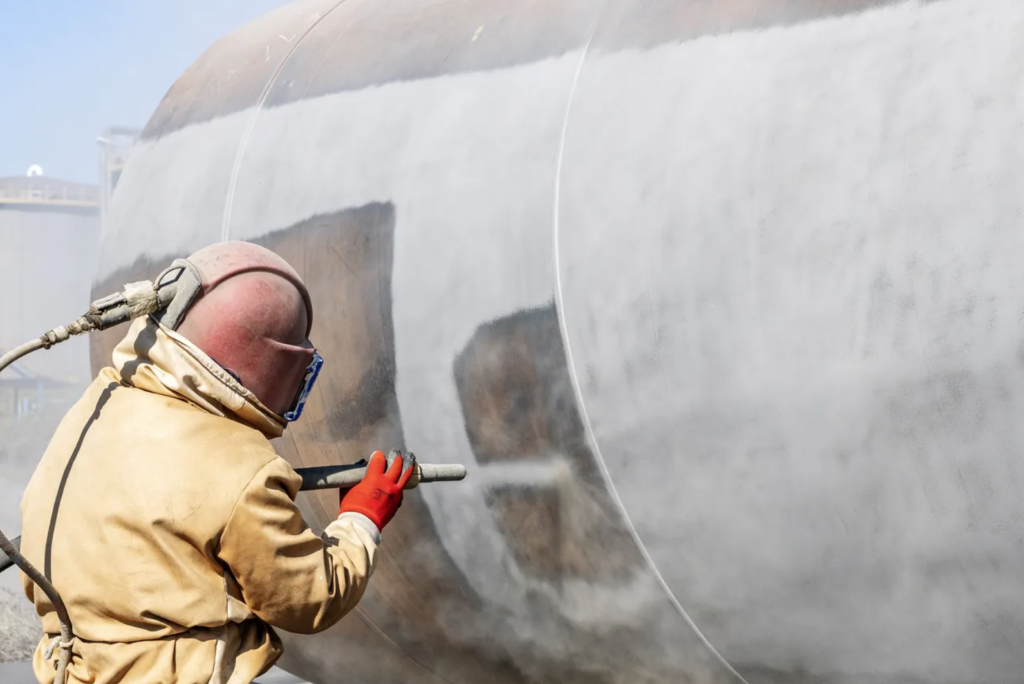We pride ourselves on our environmentally friendly practices and services. To give you a better understanding of why we choose glass abrasive above anything else, you should know more about abrasive blasting. There’s a lot that goes into finding the right kind of abrasive materials; each of them has its pros and cons. We focus on what we will get the majority of jobs done with the best results and the best options for the environment. As our world has changed, the practices that we all use should change as well. From the good to the bad, there’s a reason why everyone uses a particular type of abrasive blasting equipment.
What Is Blasting?
Simply put, abrasive blasting refers to surface preparation, making the surface smoother and ready to get cleaned for a new finish. This method uses accelerated sand size materials, with compressed air to shoot the material out in a stream at a targeted surface. The process typically creates a plum of dust particles depending on the material used for the process. The CDC has a page dedicated to the hazards of certain types of abrasive blasting. Knowing these dangers, more environmentally safe methods have developed to make this essential service better and safer. For machinery and metal surfaces, it can get rid of corrosion and rust, a common problem. When preparing a surface to get repaired or used differently, your new coat heavily relies on the surface’s condition under it. With the proper cleaning, repainting on the surface will make the entire project look like new.
Abrasive Blasting Materials
While it’s commonly known as “sandblasting,” the term is interchangeable with the term “abrasive blasting.” Since the term has evolved to become more general for abrasive blasting practices. Types of abrasive range from glass to walnut shells to baking soda. There are several kinds of soft and hard materials to use for the practice. Some are more environmentally friendly than others. Which also shows how much the method has changed over the years. Several different types of materials to use for abrasive blasting include:
Sand Blasting
Sandblasting will shoot dry silica particles or quartz as the material. This traditional method of blasting has fallen out of favor for the amount of silica in it. Silica will form dust and create a health hazard to those nearby. Many countries have completely banned silica because of these chemical hazards. The benefits of silica do not come near the number of disadvantages it has on worker’s health.
Aluminum Oxide
Known for its hardness and strength, aluminum oxide has some mixed concerns on its safety. Known for its uses for anti-slip material, industrial uses, and raw material in refractories. Companies using aluminum oxide can use abrasive blast media if the proper safety precautions get put into play at all times. From getting in your eyes, ears, and mouth, these can all lead to irritations and some mild sickness. Aluminum has even been linked to Alzheimer’s disease and other neurological disorders. However, it’s strength in etching hard metals, recyclability, and cost-effectiveness have their advantages. It’s great for grinding, polishing, and removing materials off surfaces.
Plastic Abrasive
One of the softer abrasives, plastic, is a dry thermoset cleaning material. It’s made from crushed urea, polyester, or acrylic. Depending on the project, each type has a different hardness that can change the blast’s outcome. It’s excellent for mold or other plastic removals. A few industries, such as automotive, aviation, boating, electronic and industrial, use plastic abrasives. Since it’s a soft abrasive, it won’t damage the object’s surface, but rather get unwanted materials off it. This is a great alternative to chemical paint stripping and easily recyclable.
Walnut Shell
Walnut shell has turned into a great gentle abrasive. It’s biodegradable, non-corrosive, and environmentally friendly when used for getting dirt, mold, and grime off objects. It’s used on various metals, walls, plastics, and automotive parts. It’s also great for removing graffiti and many carbon deposits that can occur from things like smoke. One of it’s most common uses are for it’s tumbling applications for polishing items like jewelry. Walnut shells are one of the hardest out of all soft abrasives, so it can’t get used for many large and intense jobs. However, it’s an excellent choice due to its safe and eco-friendly capabilities.
Texas EnviroBlast Abrasive
We use glass abrasive for our projects due to its recyclable, eco-friendly material. It’s also perfect for the wide range of jobs we do in the Southwest. You can see more information about our process and materials throughout our site. You can call us for all of your abrasive needs and more! Our mobile team can head to any residential or commercial business. Give us a call today to see how we can help you!
